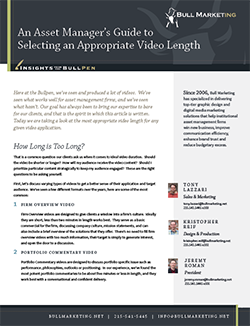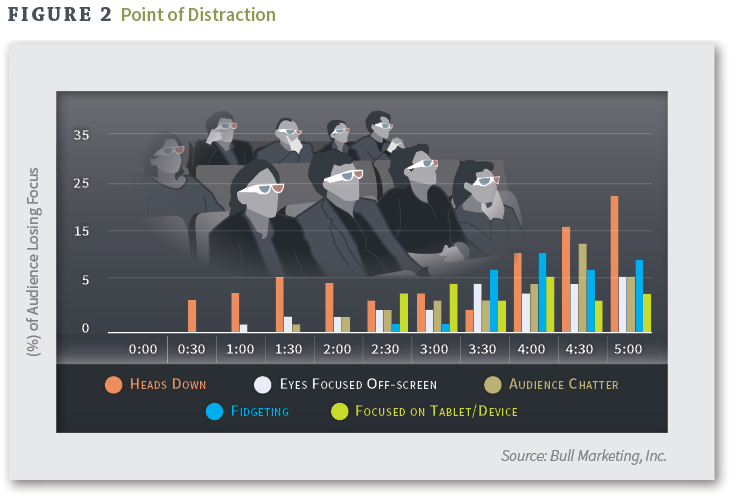
Here at the Bullpen, we’ve seen and produced a lot of videos. We’ve seen what works well for asset management firms, and we’ve seen what hasn’t. Our goal has always been to bring our expertise to bare for our clients, and that is the spirit in which this article is written. Today we are taking a look at the most appropriate video length for any given video application.
That is a common question our clients ask us when it comes to ideal video duration. Should the video be shorter or longer? How will my audience receive the video content? Should I prioritize particular content strategically to keep my audience engaged? These are the right questions to be asking yourself.
First, let’s discuss varying types of videos to get a better sense of their application and target audience. We’ve seen a few different formats over the years, here are some of the most common:
Firm Overview videos are designed to give clients a window into a firm’s culture. Ideally they are short, less than two minutes in length works best. They serve as a basic commercial for the firm, discussing company culture, mission statements, and can also include a brief overview of the solutions that they offer. There’s no need to fill firm overview videos with too much information, their target is simply to generate interest, and open the door to a discussion.
Portfolio Commentary videos are designed to discuss portfolio specific issue such as performance, philosophies, outlooks or positioning. In our experience, we’ve found the most potent portfolio commentaries to be about five minutes or less in length, and they work best with a conversational and confident delivery.
Market Commentary videos are designed to discuss specific events happening in the market. These videos work best when they are kept to under three or four minutes, but we have seen successful Market Commentaries that run closer to six minutes. The most engaging presentations often include a presenter or panel who make strong eye contact, doesn’t fidget, asks engaging questions, keeps a consistent vocal level, and carries a natural cadence.
For years we’ve seen the trends stacking up, the shorter videos are definitely more popular amongst viewers. The most effective videos deliver concise and direct information quickly and clearly without over cluttering the message. The key is to be aware of the amount of content you have and to strike a balance between the content you would like to deliver within the message against what the client has the capacity to absorb during one session.
A common mistake that some firms can make is to bloat their message. It’s a natural instinct to try and include all of the firm’s value in one video, but if the audience isn’t able to receive it effectively, the connection is lost. You can always bring up things that you omitted from the video after it attracts the viewer into a more detailed discussion, but not if you lose your audience with a video that runs too long.
Recently, Bull Marketing was challenged with producing a video presentation that was larger than the average web video scope. This video was designed to be a longer length, because the intention of the video was to take the place of live presentations at an investment conference. Very early in pre-production planning, questions arose about the best way to deliver this video so that the audience could really get the most out of the content. Our suggestion was to try to keep the video to 10 minutes or less if possible.
In total, we had over three hours of raw footage captured; a combination of live interview footage, audio testimonials, and a photo montage that all needed to be married together in the final video production. We optimized all audio and video footage then edited out the un-usable footage such as mistakes, bloopers, etc. After the edits, the video was still 30 minutes long, which was too long for our 10 minute target.
One suggestion that we made was to split some of the content up into smaller videos, which the client agreed with. This allowed the firm to spread out the presentation, keeping the content fresh and interesting. After we divided the video into smaller pieces, the primary video was ten minutes long.
As mentioned, status quo for videos these days is short and direct. We weren’t exactly sure how a 10 minute video would be received. We were hopeful that this length was appropriate because the audience was attending a conference—the attendees were not distracted by their usual daily routines—the potential for attention spans to be focused was high. This led to the idea to conduct a live study to uncover more answers, such as when and where the audience loses focus.
Snapshots of the audience were taken every thirty seconds as the video played in its entirety, our data spans for the first five minutes of the presentation. The study showed us when attention spans tapered off and what the audience shifts focus to. Here is what our study shows:

As you can see, Figure 1 shows the steady decline in the audience’s attention starting around the 0:30 second mark. By minute 3:30, there is a steep decline. By minute 4:30, more than half of the audience is losing focus. From a video production standpoint, this prompts us to ask what can we do differently to make the video more specific to the audience so the content is more captivating?

Figure 2 shows some of the distractions that popped up throughout playback: people on cell phones, people fidgeting or even carrying on individual conversations. This data shows key places where another video could be more fortified to protect against distraction. Take a look at the 1:30 mark shown on Figure 2. If the video cut to a different segment or switched to different music—note that Figure 1 simultaneously shows that 86% of the audience was still paying attention—would focus have sustained at 100% up till that point in the timeline?
At 2:30 we see the number of distractions in the room jump from three to five, and that number of distractions does not subside for the rest of the video. By 5:00, the half-way point, there are a multitude of distraction points and the audience has fallen off substantially. If we had this data prior to producing the video, we could have recommended a target video length much closer to the four to six minute range. We would have also had a window into the points where the video should have shifted gears sooner in order to reinvigorate the audience’s focus.
Bull Marketing has been working hard to blaze a trail for asset managers, finding easier and more practical ways to market through video. We are just starting to get vocal about our findings, and are interested in helping any firm who is on a quest to produce more engaging videos. We are making it our business to map the landscape for our clients. Stay tuned for more of our video studies—and studies on modern design in the investment management industry today—and feel free to comment or reach out to us directly if you have any questions.
© 2016 Bull Marketing, Inc. All Rights Reserved.